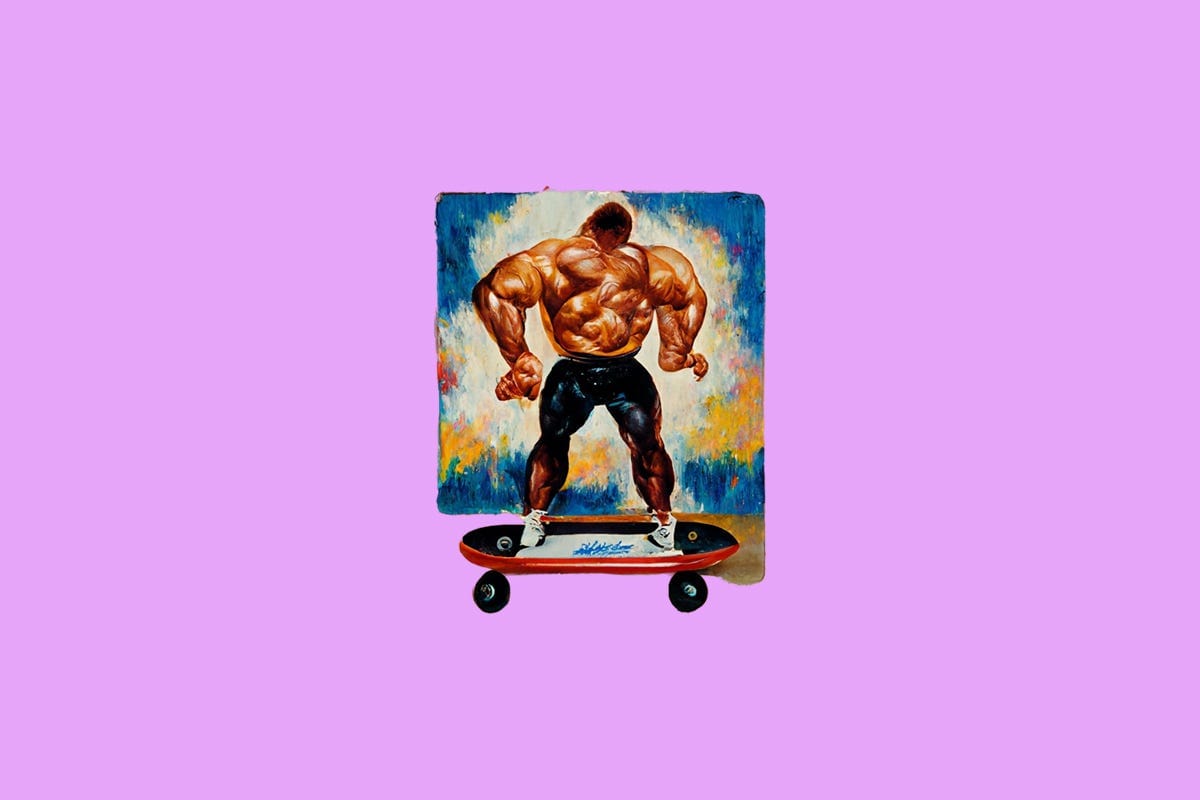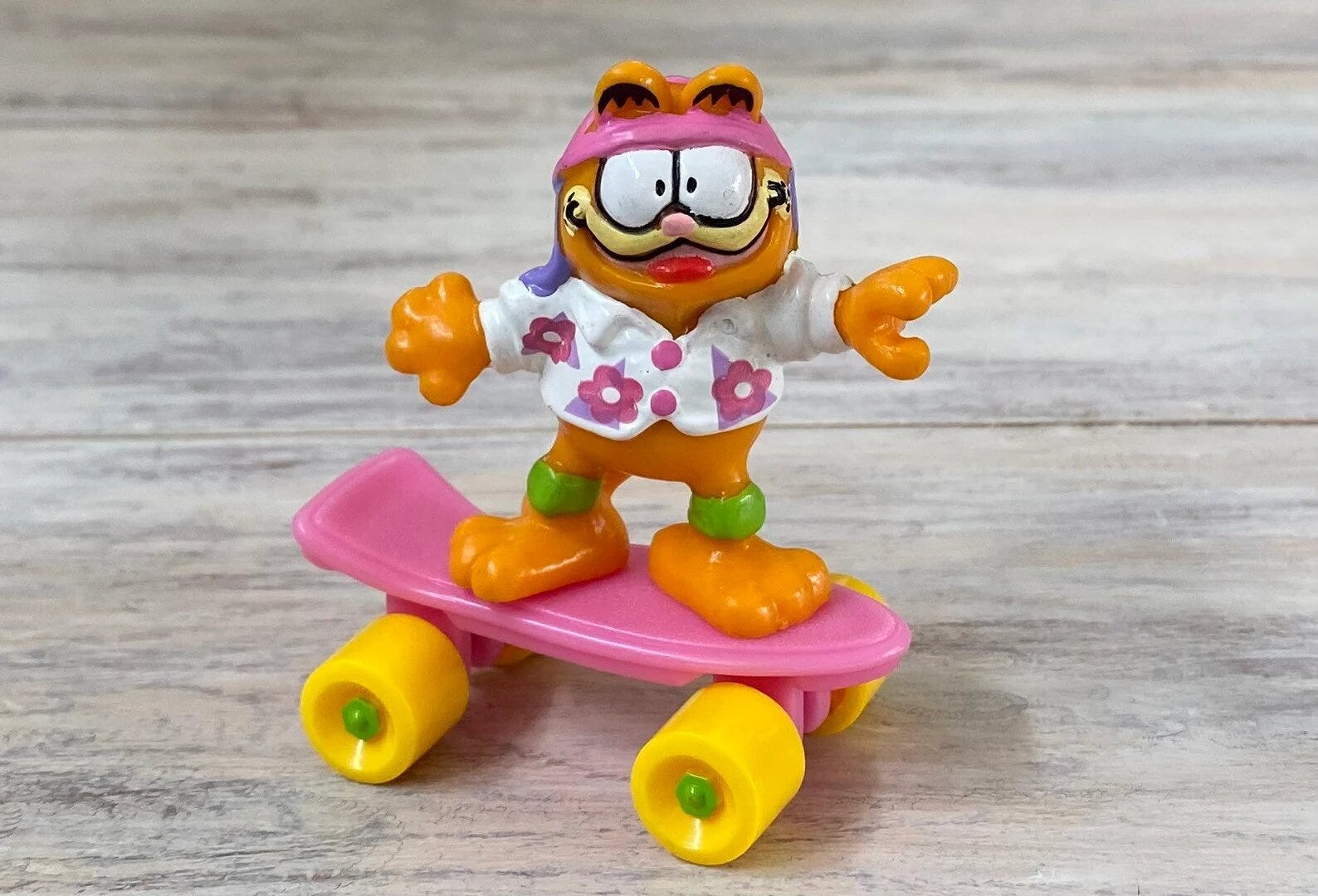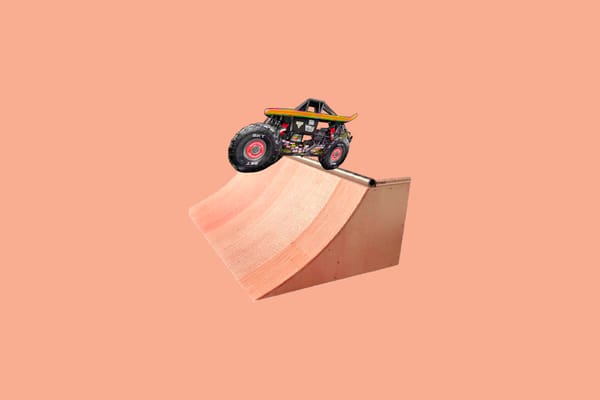The enduring novelty appeal of the skateboard
A special investigation.

A piece of plywood lies on the ground in a cluttered garage. Dusty black interlocking gym mats are placed unevenly around it. At the edge of the plywood closest to the camera filming the scene is a neatly stacked pyramid of Reign Body Fuel energy drinks—the sponsor of this video. On the far side of the plywood stands Mikey Mac O’Brien. He sways slightly under the weight of the 315-lb barbell stretched across his shoulders. Carefully he steps onto the skateboard in front of him, and in a moment of tense, crushing uncertainty, O’Brien shuffles his feet into position and pops the self-proclaimed “Heaviest Ollie Of All Time.” (It might also be the most mobbed, but you can’t blame the guy.)
This is the purest form of O’Brien’s schtick: buff guy lifts big while on a skateboard. Sometimes he’ll attach weights to his head and waist, curl and kickflip, or try a Jefferson deadlift while standing on a RipStick with his teeth biting into the grit of a skateboard. It’s a bizarre and objectively entertaining scroll through the various stunts and contraptions that populate O’Brien’s Instagram account. An account with over 167,000 followers that notes in its bio sponsorships from Reign, a smelling salt company, a clothing label, a shoe brand, and a supplement outfit called Psycho Pharma. His exploits have landed him in “local man” segments on Fox News and gotten him gawked at on The Pat McAfee Show.
With the help of a few strained flatground tricks, O'Brien has built a following that eclipses most professional skateboarders’. Including his brother, Alien Workshop pro Joey O’Brien. Last year, Joey released one of the best video parts of the decade and was in contention for Thrasher Magazine’s coveted Skater of The Year award. However, compared to his yolked sibling, he currently sits at a paltry 12.9 thousand Instagram followers.
For the muscled O’Brien, the key ingredient to his online success has undoubtedly been the skateboard. Without it, he’s simply lifting weights, but with it, the whole dynamic shifts. The skateboard is used to drive tension by adding an element of impending danger and slapstick—it’s the rake you’re just waiting for him to step on. This also removes it from the context that skateboarders understand it (as the nucleus of the entire personal, cultural, and industrial worlds we’ve built for ourselves) and puts it back into the place that most of the world sees it: as merely a prop.
The novelty of the skateboard as a curiosity and low-wattage gag in popular culture is essentially its urtext. For decades it’s been deployed like this. From Paul McCartney, Katharine Hepburn, and seemingly every celebrity from the 1960s-1980s having their respective photo op standing on one, to Ronald McDonald Mr. Magoo-ing his way through the city on a skateboard on his way to enjoying a Happy Meal in the late 1990s—the skateboard’s inherent gimmickyness has always been its mainstream draw. And it’s still just as potent in the age of social media.
Remember @doggface208? Otherwise known as Nathan Apodaca, the viral TikTok sensation whose front-facing camera video of himself [long]boarding down the road and drinking cranberry juice while lip-syncing Fleetwood Mac’s “Dreams” had such an impact that it brought the legendary band back into the Billboard Hot 100 for the first time in four decades. He’s since parlayed that quick rise into millions of social media followers, endorsements from various brands, his own video game, and even a guest appearance on a George Lopez sitcom on NBC. Would any of that have happened if Apodaca hadn’t been riding a [long]board in that TikTok? Unlikely.
So what is it about the skateboard that continues to make it such a formidable catalyst for virality and pop culture appropriation? Is it because of the intrinsic danger of riding one? There seems to be a general consensus that riding a skateboard is hard, so if your stunt includes one, it must add to the stakes. It could also be the playful juxtaposition of this eternal fragment of youth culture (cowabunga dude) butting up against any other cultural reference point.

Or, to the general public, perhaps skateboarding just looks silly. It is, after all, a toy that managed to grow a culture like a mould. The public at large doesn’t need to recognize the teeming organism that lives on and through the skateboard to understand its base function. How often has a viral video of a bulldog riding a skateboard come across your social media feed? It’s impossible to quantify. The millions of people watching and sharing that sort of Upworthy-esque drivel can enjoy it without having any idea who the Piss Drunx were, why we’re all hailing Cardiel, or why there’s a thick smear of wax on the back of their jeans after sitting on a park bench.
And even when popular culture does focus on people who ride the skateboard well, it tends to be in the extreme. If Jake Brown didn’t fall several stories to the flat of the MegaRamp’s quarterpipe and have his shoes explode off his feet like a goddamn cartoon character, there’s no way he would’ve been a guest on Larry King Live following the 2007 X Games. Nyjah Huston has probably had more mainstream coverage about upsetting his neighbours with raucous house parties than his on-board accomplishments. The skateboard is almost always secondary to the drama used to sell a story to the casual audience.
Which, you know, is expected. That’s how these things usually work, regardless of the activity. A highlight of a guy throwing an opening pitch at a baseball game and hitting a bystander in the nuts will have broader appeal than a homerun highlight because a guy getting hit in the nuts is a universal language. What’s different is that skateboarding can’t seem to move beyond the guy-getting-hit-in-the-nuts phase of its public perception. In 2017, the World Baseball Softball Federation estimated that there were 65 million baseball players globally. The most recent figure that gets thrown around without proper citation is that there are 85 million active skateboarders worldwide. If those numbers are close to accurate, you’d imagine there would be more appetite for actual skateboarding content in popular culture. But even when skateboarding-as-a-sport had its moment in the sun as the opening event for the Tokyo 2020 Olympics, that attention didn’t last long. And the most memorable highlight from the games? That would probably be Angelo Caro reverse baseball sliding his crotch into a rail.
Will the skateboard ever reach beyond the general public’s narrow understanding of it? Is it fated to forever be seen by the masses as a novelty, a gag, and a subcultural fashion accessory? But more importantly, does it matter? We’re pretty happy here in our bubble, even if some mainstream appreciation and opportunities would be nice every once and a while. It feels criminal that Joey O’Brien isn’t a bigger name and getting paid as such, but we can’t also be ignorant of reality. Your Average Joe doesn’t care to know a sugarcane from a ho-ho, but if Mikey replaces the wheels of his board with 20-lb dumbbell plates and attempts the world’s heaviest late shuv, you know Average Joe is watching. That’s the skateboard’s inescapable duality. Those who love it in the way we do can be stupidly serious about it, while the casual audience can watch the world’s fastest skateboarding dog and get more out of that seriously stupid spectacle than any groundbreaking video part.
But what if the contention here isn’t as insurmountable as it seems? Maybe there’s a mutually beneficial future that exists somewhere in the middle. A way the stupid and the serious can help elevate one another to a greater plane. Where the rising tide of mainstream exposure can benefit the serious and where the legitimacy of the core can add extra intrigue to the stupid.
(Another) Joey and Mikey Mac O’Brien shared part, anyone?





